
ElixirConf.EU 2019
I was lucky enough to attend ElixirConf.EU for the third time and in this post I’m sharing some thoughts about the talks I saw, some of my notes and insights on the future of this community in general.
Location
I’d never visited Prague before and the conf was an amazing opportunity to combine business and pleasure. While writing this post though, a week after, I realised I didn’t visit most of the landmarks that I was planning to. Looks like I was immersed in the vibe of the city and had a great time there 😀.

The Fun Stuff
In the few nights spent in Prague, I picked out the following places, which I wholeheartedly recommend:
Now for the Czech cuisine, I don’t remember much, but the bread dumplings (Knedlíky?) and the guláš were quite tasty. The beer on the other hand didn’t match my taste.
The venue
Spacious, clean and only a short commute from my staying.
Conference - Day 1
Keynote - The Road to Broadway - José Valim
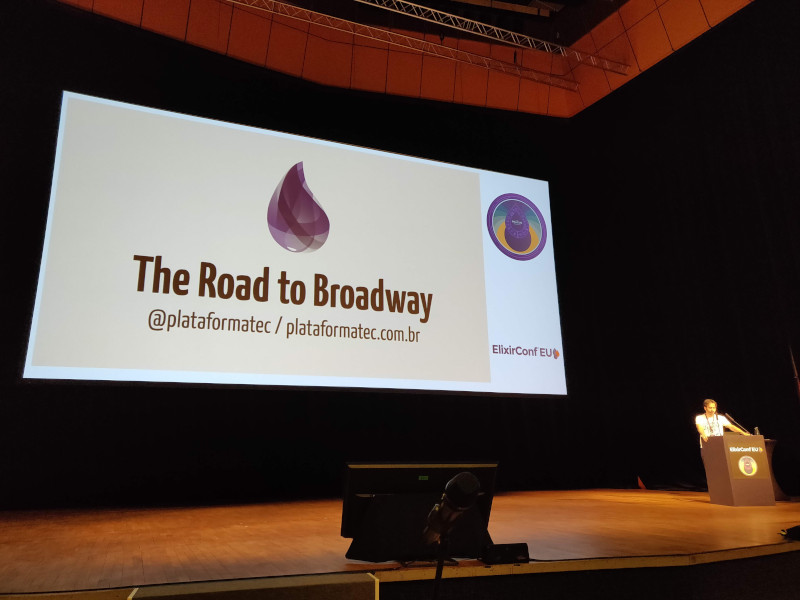
The talk was about broadway, a new open source project by Plataformatec aiming to streamline data processing pipelines.
The presentation started with a short history of steps towards the goal of making collections from eager -> lazy -> concurrent -> distributed.
Imagine the following:
File.stream(path)
|> ...
|> Stream.async()
|> ...
|> Stream.async()
|> ...
|> Stream.run
The issues with it are that it’s:
- Too manual
- Moving data between processes a lot
- Hard to reason about fault-tolerance
A better abstraction was needed and thus GenStage was born.
It was inspired by Akka streams and the Akka team was helpful and answered many questions.
Some of the companies using GenStage in production:
Broadway
Broadway takes the burden of defining concurrent GenStage topologies and provide a simple configuration API that automatically defines concurrent producers, concurrent processing, batch handling, and more, leading to both time and cost efficient ingestion and processing of data.
Features:
- Back-pressure
- Automatic acknowledgements at the end of the pipeline
- Batching
- Automatic restarts in case of failures
- Graceful shutdown
- Built-in testing
- Partitioning
Coming up:
- Multiple processors
- Metrics and statistics
Surprisingly in the audience 2 or 3 people raised their hands when José asked who’s using Broadway already in production.
Want to contribute? Write a producer.
Available producers:
Q & A
Q. Can I build a producer in another language?
Totally doable as long as there’s a API for that external app.
Q. Is there an overlap between Flow and Broadway?
Flow focuses on data aggregation. Broadway is about the individual messages and not the data as a whole.
I’m really looking forward to use broadway in some project, it might be the perfect abstraction for some of the problems, I’m solving over and over from scratch.
Q. Is the goal to replace RabbitMQ or Kafka?
No, it’s to work with them and become very good friends.
Rewritting Critical Software in Elixir - Renan Ranelli
The talk was a case study of adopting Elixir at Telnyx. Telnyx aims to be like AWS but for telcos.
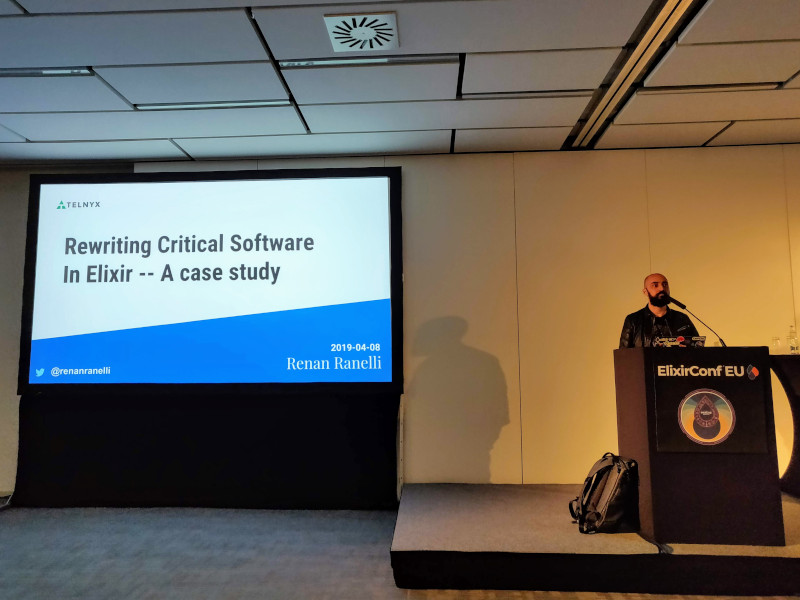
They went to rewrite a dialplan service which was originally written in Python to Elixir.
Python is notoriously harder to scale vertically & horizontally than Elixir
Characteristics of the service:
- Uses freeswitch XML to route calls
- Stateless
- Latency sensitive
- Low throughput
The migration to the new Elixir service was challenging, since changes kept being made in the Python codebase, making it a race for feature parity.
They approached the problem by routing production traffic to both the existing Python service and the experimental Elixir one, capturing the responses and diffing them, to verify compatibility.
They used the responses to automatically generate regression tests.
For them, the experiment was successful as parallelisation was ridiculously simpler and cheaper with Elixir.
Tortoise Evolved - Martin Gausby
This talk was about Tortoise, an MQTT client for Elixir.
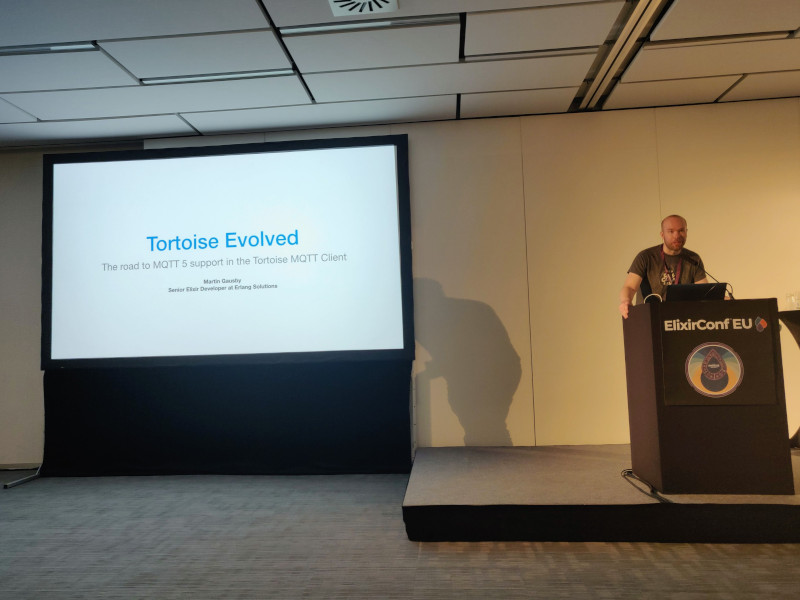
MQTT is a lightweight Publish/Subscribe (PubSub) protocol, designed to operate on high-latency networks or unreliable networks. It’s commonly used in IoT.
You publish messages in topics. Topics are namespaced using slashes, for
example ocp-tower/2/temperature.
A client can subscribe to messages using topic filters.
Example:
Start a connection process:
client_id = "toes"
{:ok, pid} = Tortoise.Connection.start_link(
client_id: client_id,
server: {Tortoise.Transport.Tcp, host: 'localhost', port: 1833},
handler: {Tortoise.Handler.Default, []}
)
Then publish a message:
topic = "ocp-tower/3/temperature"
payload = <<21::float-32>>
Tortoise.publish(client_id, topic, payload, [qos: 0])
Upcoming Changes
- Tortoise (for MQTT .1.1) is ready for production today
- MQTT will cause some changes to the API
- MQTT 5 support in a branch, kinda works, but needs some time
- Tortoise will drift towards a low-level API to support everything
I wanted to ask, if there’s plan for a Broadway producer in Tortoise, but I completely forgot about it.
Let there be light - Michał Muskała
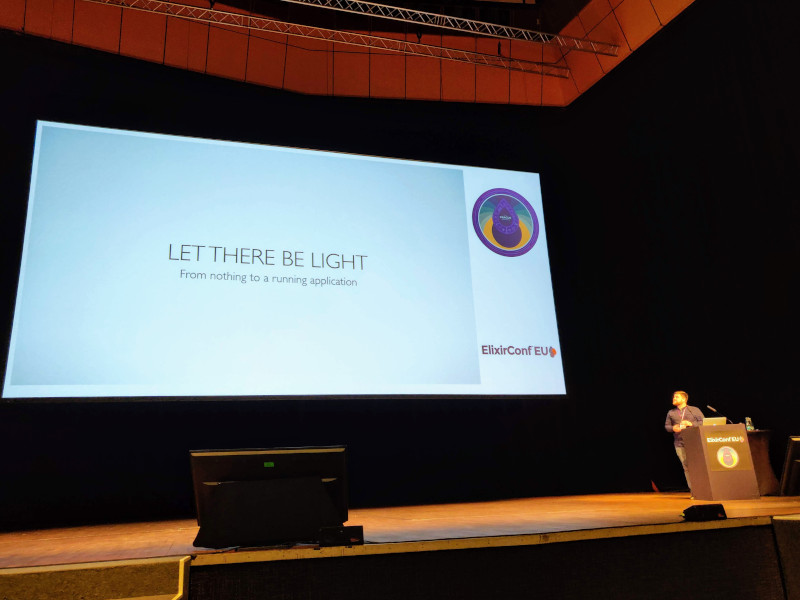
This talk tries to explore the necessary steps for an Erlang application to boot.
So..
./bin/erlis a sh script, which callserlexecerlexeccalls beam-smp (OTP 21 removed single-threaded implementation)erl_init.c- configures time monitoring for time-warp mode. The BEAM has its own way to measure time
- starts thread progress services (see: here)
- sets the stack size - 1 MB for regular schedulers and 320 KB for dirty schedulers
- starts a bunch of system processes
- Some essential modules cannot be reloaded and are bootstrapped as embedded C arrays. See preloaded/src/Makefile
- There’s Perl in the codebase, see instrs.tab
beam_emu.c- Implements the main process loop
- A huge-function with goto all over the place
- Generated from pseudo-C by perl scripts into C with macros on top of macros
- Implements bytecode different from BEAM files and a translation is done by the loader
- There’s an undocumented flag
profile_boot, which profiles the boot operation - You can do some Ruby-like metaprogramming using
$handle_undefined_function, but please don’t!
Key Takeaways
- Many VM services are implemented in Erlang
- Command-line arguments are parsed many times each time an erlang program is started (It’s 6 may 7 times, I cannot recall exactly)
- Elixir adds layers on top and underneath the OTP boot process
- Lot’s of command-line arguments of the VM are not well documented
- It looks like there’s a module for everything in OTP
For me this was the most insightful and true talk of the conference. No marketing talk, not another success story. Digging into the core of the system, trying to see how it works. I love code exploration talks. You can learn so much from them.
My face after @michalmuskala's talk today. #ElixirconfEU pic.twitter.com/HqdHdtUVbN
— Dimitris Zorbas (@_zorbash) April 8, 2019
By the way the brewery (link), where the above photo was taken is awesome.
An Adventure in Distributed Programming - Wiebe-Marten Wijnja
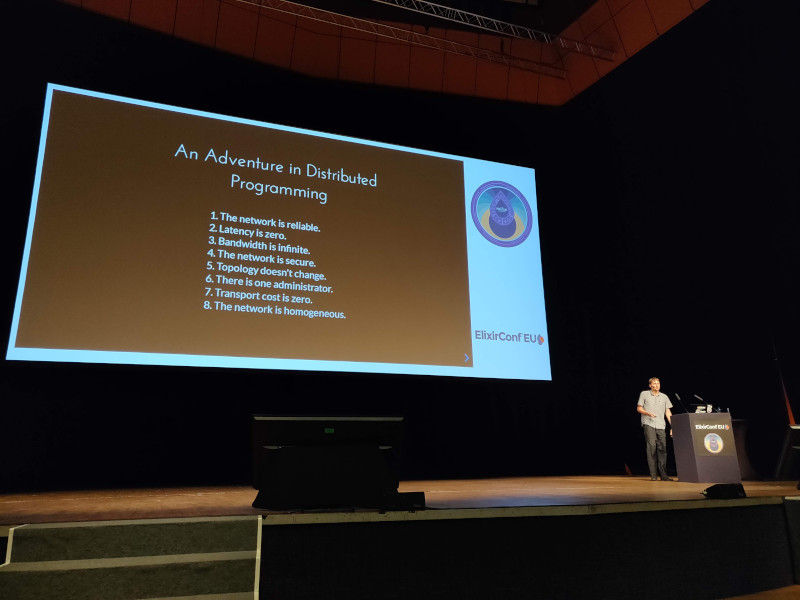
This talk was about Planga a chat application and the challenges they faced building it. The app is open-source.
There were references to:
- The CAP theorem
- The byzantine generals problem
- Comparison of distributed databases {Mnesia, Cassandra, CouchDB, Riak}
Planga’s working on an Ecto adapter for Riak, see here.
Remarks
- Distributed applications are hard
- Elixir makes it reasonably bearable
- Tooling can be (and is being) improved
Projects to Check out
Q & A
Q. CRDTs. How do you use them? Any patterns?
It depends what you’re trying to abstract. We use Riak CRDTs which I believe use delta-CRDTs.
Q. Why did you stop using Mnesia?
The Ecto adapter was far from perfect and also we wanted a DB which doesn’t live in the node.
Building Resilient Systems with Stacking - Chris Keathley
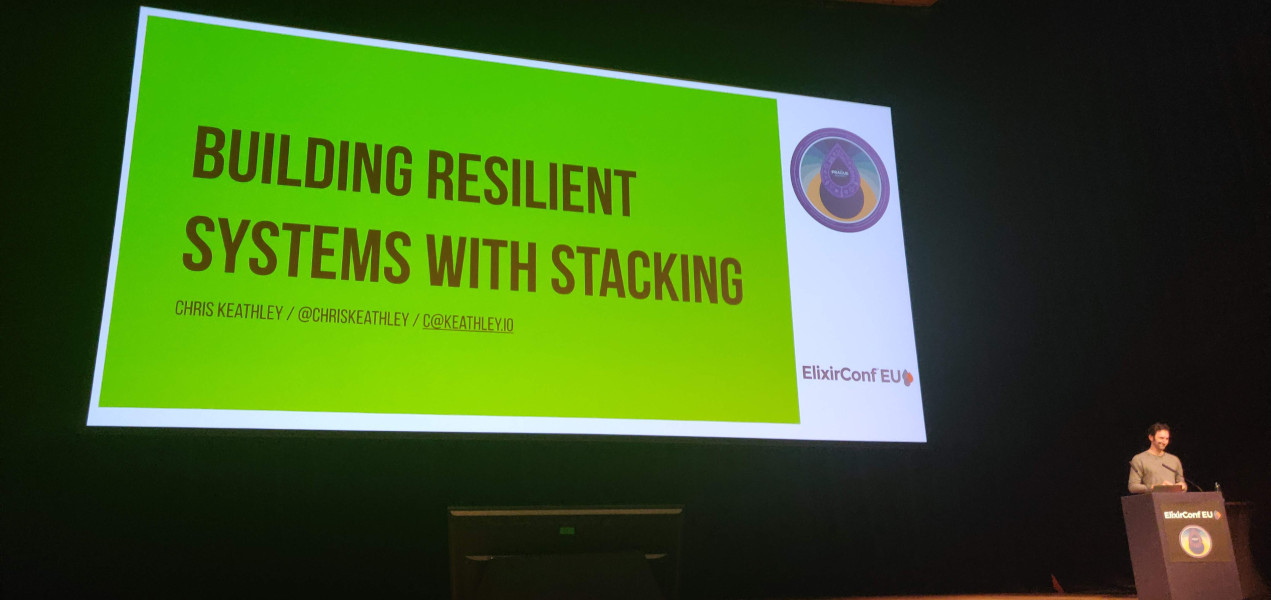
Alternate Title: “How to boot your apps correctly”
Definitions:
Resilience
An ability to recover from or adjust easily to misfortune or change.
System
A group of interacting, interrelated, or interdependent elements forming a complex whole.
…complex systems run as broken systems. The system continues to function because it contains so many redundancies and because people can make it function, despite the presence of many flaws… System operations are dynamic, with components (organizational, human, technical) failing and being replaced continuously.
Scaling is a problem of handling failure
This is why Erlang is so good at scale.
You have to treat humans as first-class citizens.
Don’t use mix for runtime config.
See: https://github.com/keathley/vapor
defmodule Jenga.Config do
use GenServer
def start_link(desired_config) do
GenServer.start_link(__MODULE__, desired_config, name: __MODULE__)
end
def init(desired) do
:jenga_config = :ets.new(:jenga_config, [:set, :protected, :named_table])
case load_config(:jenga_config, desired) do
:ok ->
{:ok, %{table: :jenga_config, desired: desired}}
:error ->
{:stop, :could_not_load_config}
end
end
defp load_config(table, config, retry_count \\ 0)
defp load_config(_table, [], _), do: :ok
defp load_config(_table, _, 10), do: :error
defp load_config(table, [{k, v} | tail], retry_count) do
case System.get_env(v) do
nil ->
load_config(table, [{k, v} | tail], retry_count + 1)
value ->
:ets.insert(table, {k, value})
load_config(table, tail, retry_count)
end
end
end
To watch for the health of your system’s components, you can use alarms.
Example:
defmodule Jenga.Database.Watchdog do
use GenServer
def init(:ok) do
schedule_check()
{:ok, %{status: :degraded, passing_checks: 0}}
end
def handle_info(:check_db, state) do
status = Jenga.Database.check_status()
state = change_state(status, state)
schedule_check()
{:noreply, state}
end
defp change_state(result, %{status: status, passing_checks: count}) do
case {result, status, count} do
{:ok, :connected, count} ->
if count == 3 do
:alarm_handler.clear_alarm(@alarm_id)
end
%{status: :connected, passing_checks: count + 1}
{:ok, :degraded, _} ->
%{status: :connected, passing_checks: 0}
{:error, :connected, _} ->
:alarm_handler.set_alarm({@alarm_id, "We cannot connect to the database”})
%{status: :degraded, passing_checks: 0}
{:error, :degraded, _} ->
%{status: :degraded, passing_checks: 0}
end
end
end
When communicated with other services, you may want to use circuit-breakers. For BEAM projects fuse is the go-to library.
Lessons From our first trillion messages with Flow - John Mertens
John is a principal engineer for https://change.org It’s written primarily in Ruby, but they started adopting Elixir in 2018.
This is an example of how they use Flow:
SqsClient.sqs_producers()
|> Flow.from_stages()
|> Flow.map(&prep_incoming_message/1)
|> Flow.map(&run_biz_logic/1)
|> Flow.map(&commit_side_effects/1)
|> Flow.map(&log_errors/1)
|> Flow.partition(window: ack_window, stages: 1)
|> Flow.reduce(fn -> [] end, &ack_accumulator/2)
|> Flow.on_trigger(fn messages ->
ack_messages(messages, queue_name)
{[], []}
end)
With the help of pattern-matching they can handle a variety of data:
@spec run_biz_logic(Message.t()) :: Message.t()
def run_biz_logic(
%Message{status: :ok, message_type: "click"} = msg
) do
# functionality for the "click" message type
end
def run_biz_logic(
%Message{status: :ok, message_type: "sign"} = msg
) do
# functionality for the "sign" message type
end
A glimpse of Broadway from change.org’s codebase:
def start_link({input_queue: queue, sqs_worker_count: producers) do
Broadway.start_link(__MODULE__,
name: __MODULE__,
producers: [
default: [
module: {BroadwaySQS.Producer, queue_name: queue},
stages: producer_count
]
],
processors: [default: [stages: 100]],
batchers: [default: [batch_size: 10, batch_timeout: 5_000]]
end
def handle_message(_, %Message{data: sqs_msg} = message, _) do
new_msg =
sqs_msg
|> prepare_incoming_message()
|> run_biz_logic
|> commit_side_effects()
|> log_errors()
case new_msg.status do
:error ->
Message.failed(message, new_msg.status_metadata.error.response
_ ->
Message.update_data(message, fn _ -> new_msg end)
end
end
Ecto without SQL - Guilherme de Maio
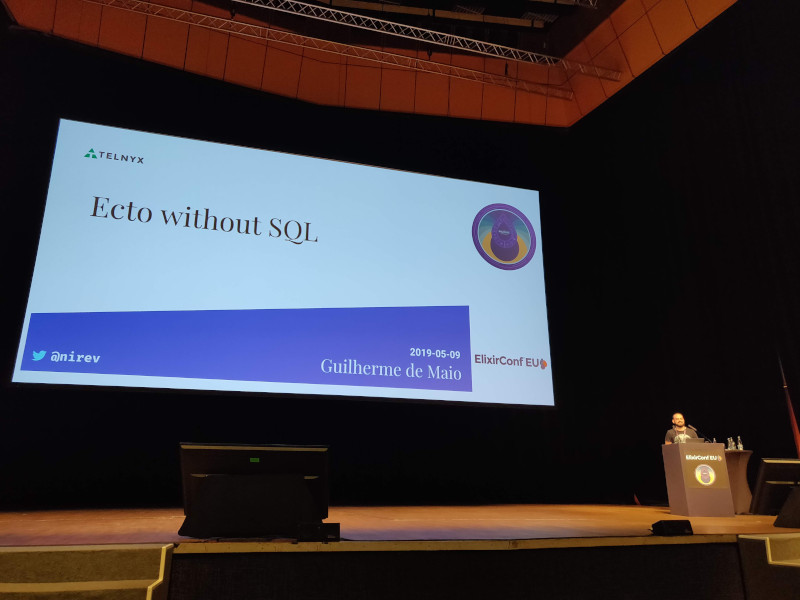
It turns out [Ecto][ecto] is more than a database library for Elixir.
Ecto is a toolkit for data mapping and language integrated query for Elixir
the main modules of Ecto are:
- Schema
- Changeset
- Repo
- Query
It’s not an ORM.
Defining a type:
defmodule Sample.Phone do
@behaviour Ecto.Type
defstruct [:number]
def type, do: :string
def cast(string) when is_binary(string) do
case Phone.parse(string) do
{:ok, phone} -> {:ok, %__MODULE__{number: format(phonenumber)}}
_otherwise -> :error
end
end
def cast(phone = %__MODULE__{}), do: {:ok, phone}
def cast(nil), do: {:ok, nil}
def cast(_), do: :error
def dump(%__MODULE__{number: string}), do: {:ok, string}
def dump(nil), do: {:ok, nil}
def dump(_), do: :error
def load(nil), do: {:ok, nil}
def load(string), do: {:ok, %__MODULE__{number: string}}
end
You can use Ecto without SQL. By defining an adapter.
Some examples:
- https://github.com/circles-learning-labs/ecto_adapters_dynamodb
- https://github.com/jeffweiss/ecto_ldap
- https://github.com/ankhers/mongodb_ecto
- https://github.com/wojtekmach/ets_ecto
- https://github.com/almightycouch/rethinkdb_ecto
However Ecto.Query is very SQL-centric.
You may use changesets without Repo for validations. Example:
defmodule ApiWeb.Call.AnswerValidator do
@moduledoc """
Validate requests to answer command
"""
@schema %{client_state: :string}
@all_fields Map.keys(@schema)
use ApiWeb.Validator, schema: @schema
alias ApiWeb.Validator.ClientStateValidator
def changeset(changeset, params) do
changeset
|> cast(params, @all_fields)
|> ClientStateValidator.validate_client_state()
end
end
This is a way to get a consistent error handling strategy for controller actions.
Closing Keynote - Chris McCord
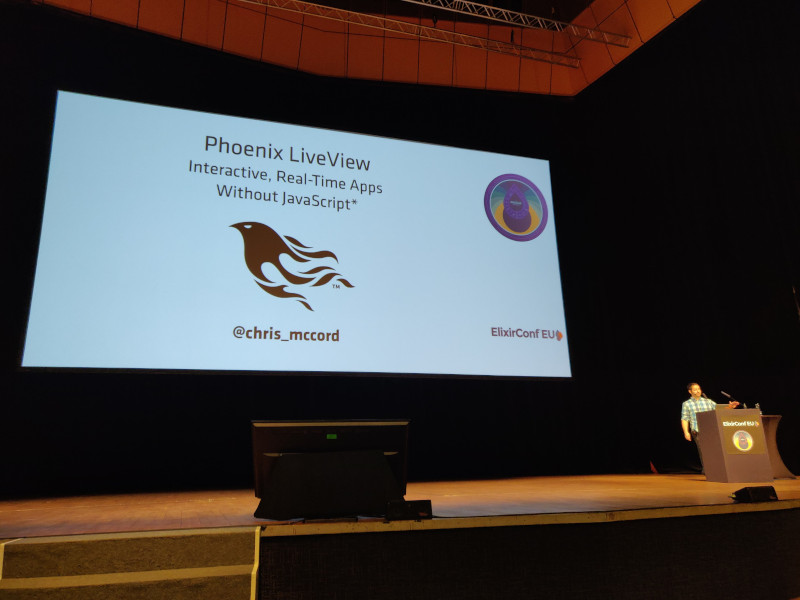
The idea is to be able to write interactive, Real-Time apps that are “scriptless”, meaning that you don’t have to write any JavaScript.
Chris showed the following demos on stage:
- https://liveview.zorbash.com
- https://elegant-monstrous-planthopper.gigalixirapp.com
- https://flappy-phoenix.herokuapp.com/game
- https://polite-angelic-beaver.gigalixirapp.com
Imagine my surprise and excitement when Chris opened a browser tab with the first demo, which I wrote 🥳 You may read my previous post about that.
He said, they’re going to be able to use LiveView to lift information out of the VM and produce the Phoenix Telemetry integration.
For more demos, guides and tutorials about LiveView, check out this list.
So Chris said that LiveView isn’t going to replace SPA frameworks. For example one wouldn’t write google docs, or google maps using LiveView. However there’s many simpler apps which can be written with LiveView, avoiding the rabbit hole of complexity of client-side development.
LiveView is a new paradigm questioning some of the existing techniques for developing interactive apps. Imagine building an interactive thermostat UI like this one. You’d need to code:
Server
- Define routes
- Create Controller / Channel
- Define JSON/payload contracts
Client
- Handle events and syncing state
- Handle client actions
- Handle error recovery
- Navigate the JS library labyrinth
That thermostat example, can be coded like:
defmodule DemoWeb.ThermostatView do
use Phoenix.LiveView
import Calendar.Strftime
def render(assigns) do
~L"""
<div class="thermostat">
<div class="bar <%= @mode %>">
<a phx-click="toggle-mode"><%= @mode %></a>
<span><%= strftime!(@time, "%r") %></span>
</div>
<div class="controls">
<span class="reading"><%= @val %></span>
<button phx-click="dec" class="minus">-</button>
<button phx-click="inc" class="plus">+</button>
</div>
</div>
"""
end
def mount(_session, socket) do
if connected?(socket), do: Process.send_after(self(), :tick, 1000)
{:ok, assign(socket, val: 72, mode: :cooling, time: :calendar.local_time())}
end
def handle_info(:tick, socket) do
Process.send_after(self(), :tick, 1000)
{:noreply, assign(socket, time: :calendar.local_time())}
end
def handle_event("inc", _, socket) do
{:noreply, update(socket, :val, &(&1 + 1))}
end
def handle_event("dec", _, socket) do
{:noreply, update(socket, :val, &(&1 - 1))}
end
def handle_event("toggle-mode", _, socket) do
{:noreply,
update(socket, :mode, fn
:cooling -> :heating
:heating -> :cooling
end)}
end
end
Where the EEx part of it, can be extracted to a separate file.
An important aspect of app development with LiveView is failure isolation. With a JavaScript application, an exception, unless rescued would freeze the UI. However with LiveView a process isolates failure and restarts a view with a known good state.
Optimisations
LiveView uses morphdom to optimally update the DOM with the changes pushed down the web socket. LiveView tries to push only the changes in the state and positions in the markup to be updated.
In the future the ability to throttle keyboard events will be added and there’s an open issue for that.
First-Class Testing
With code like the following, you can test-drive your statefull actual running process without a browser.
test "thermostat controls" do
{:ok, thermo_live, _html} = mount(Endpoint, ThermostatLive)
assert render(thermo_live) =~ "70°"
assert render_click(thermo_live, :inc) =~ "71°"
assert [clock_live] = children(thermo_live)
assert render(clock_live) =~ ~r/..:.. [A|P]M/
:ok = GenServer.call(clock_live.pid, {:set, "12:01 PM"})
assert render(clock_live) =~ "12:01 PM"
end
Finally Chris also showed a comparison of library sizes to build an interactive app:
| Name | Size (minified) |
|---|---|
| LiveView.js + morphdom | 29K |
| Vue 2.5.20 | 88K |
| React 16.6.3 + React DOM | 112K |
| Ember 3.0.0.beta.2 | 468K |
Next Steps
- Optimised collections with prepend and append operations
- pushState support for proper URLs on state change
- Enhanced loading states
- File uploads
- Guides
- Initial hex release
Q & A
Q. WebSockets don’t work in some cases where there are proxes
You can give it the longpoll option
Q. What about working on an open standard?
It would impede development. We can get to specify it at some point. Too early to say.
Q. Does it work without JS (for SEO)?
If you curl it, responds with the expected HTML, so yes.
Outro
You might also be interested to read:
- Martin Gausby’s thoughts on this year’s conf
- Read my previous posts for 2018 and 2017
- This list of bookmarks from the conference
Spotted a Mistake?
Please contact me on twitter, or in the comments, or submit a PR for corrections.
